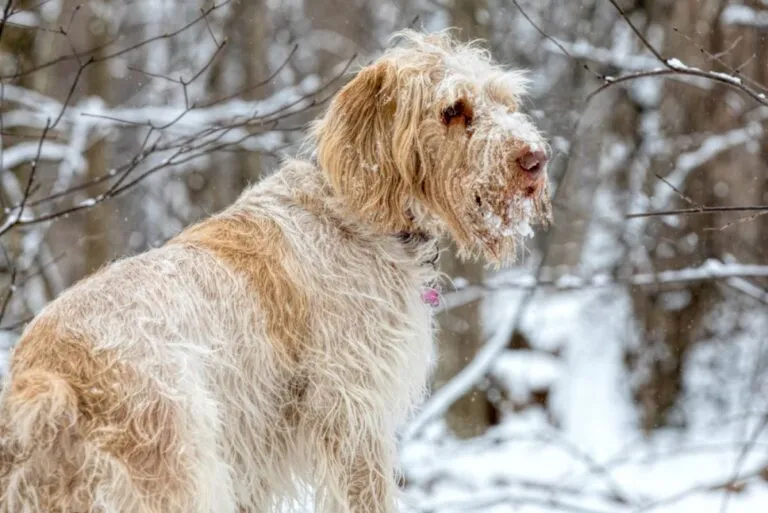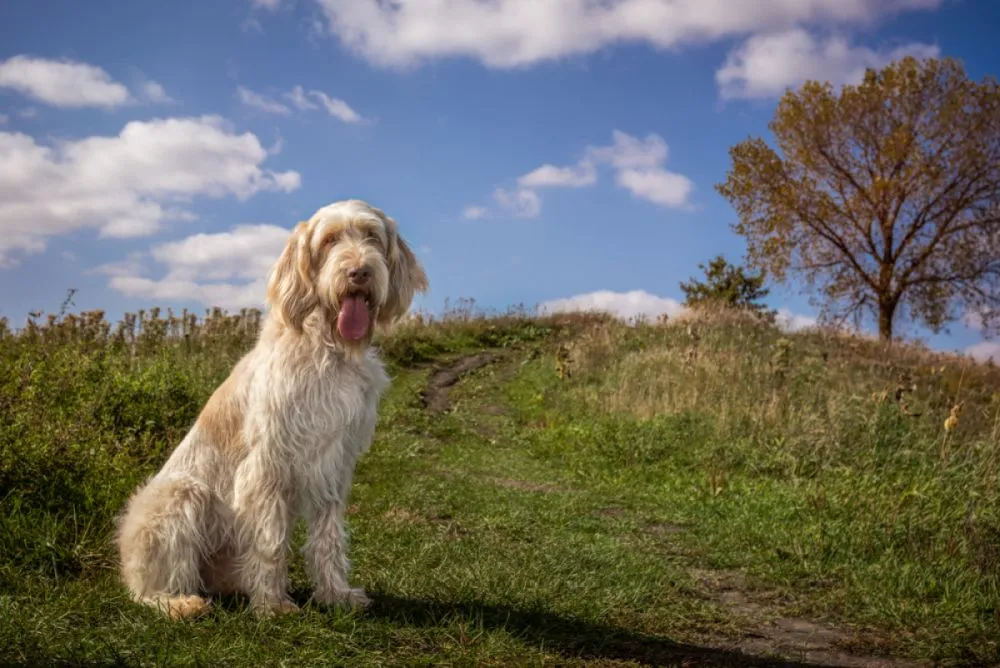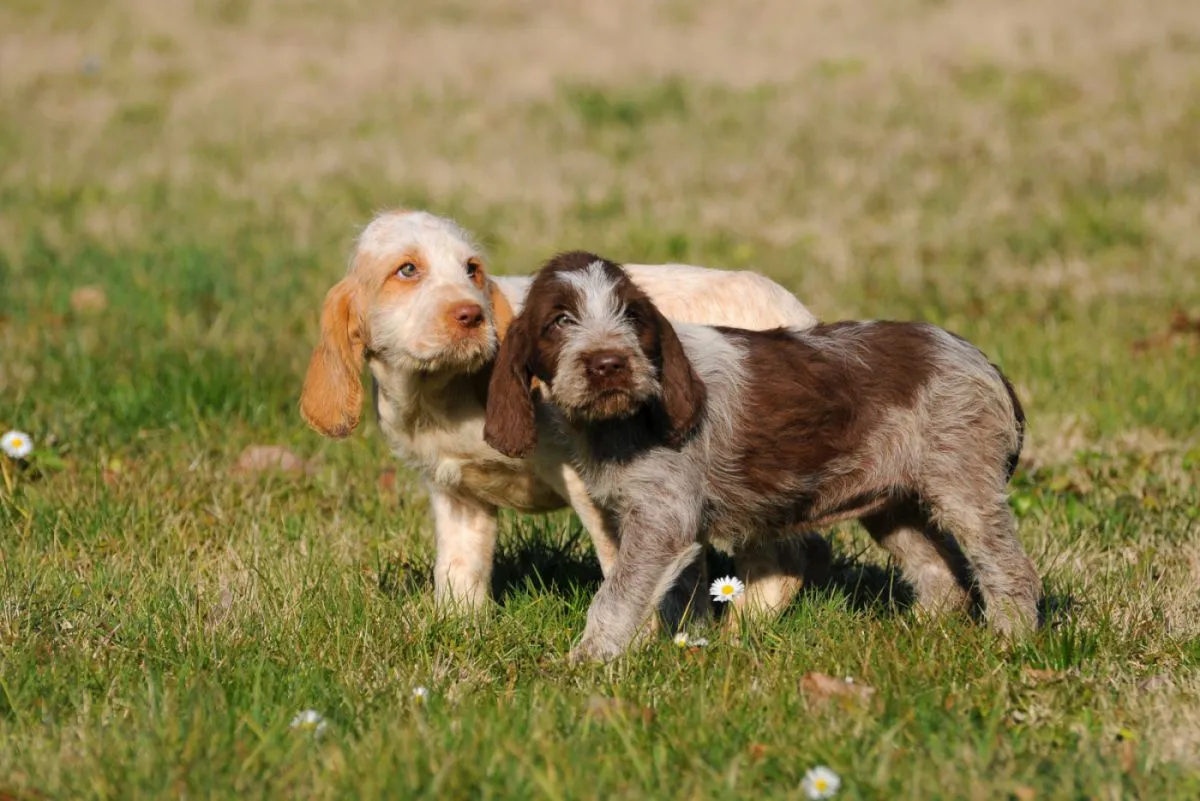Medium Size Poodle
Outside its native Italy, the Spinone Italiano is rarely seen. This breed is still something of an insider tip for anyone looking for a friendly hunting dog that can also be kept purely as a companion.

© luminosity-images / stock.adobe.com
The Spinone Italiano is an ancient and rare breed of dog from Italy.
The Spinone Italiano has a strong bone structure and is well-muscled. Its long floppy ears combined with its beard give it a serious look at first glance.
But its expressive eyes melt the hearts of dog lovers time and again.
The Italian Spinone is one of the larger dog breeds: males stand 60 to 70 centimetres tall and weigh between 32 and 37 kilograms. Females are smaller, with a shoulder height of 58 to 65 centimetres and a weight between 28 and 32 kilograms.
The build of this breed is more rectangular than square. For a long time, it was common practice to dock the upright tail of the Spinone Italiano.
There are several theories, but it’s likely the Spinone got its name from the texture of its coat: dogs of this type were first called “bracco spinoso”, meaning “spiky hound”, and later “bracco spinone”. Accordingly, the Spinone has a “spiky”, that is, wiry, long topcoat.
Permitted coat colours are white, brown, white-orange or brown ticked or roan. The nose is either liver-coloured or brown, but never black.
This dog is known for its strong work ethic combined with great sensitivity. It is a versatile, intelligent and very people-friendly breed. The Spinone is generally sociable with other dogs too.
In situations where it feels threatened, the Spinone may show protective instincts. While the adult Spinone Italiano is calm and patient, it does need plenty of daily activity for both body and mind.
The Spinone Italiano is considered easy to train. It is not aggressive and loves working together with its human. However, it does have a mind of its own and can sometimes be a bit stubborn.
Alongside appropriate mental and physical stimulation, gentle consistency is the key to successfully training a Spinone Italiano.
This breed is very sensitive and suffers especially from harsh corrections. If the Spinone is not used for hunting and does not undergo hunting dog training, anti-hunting training can be helpful.
Many dogs of this breed tend to bark – for example, when the doorbell rings. From puppyhood, you can guide the barking in the right direction so it doesn’t turn into excessive yapping.
The Spinone Italiano needs close contact with its human family and plenty of time in nature. If you can provide this, you can happily keep this sociable dog even in a (spacious) flat.
Good to know: Because of the Spinone’s size, the flat should ideally be on the ground floor or accessible by lift.
Even non-hunters can welcome the hunting dog as a family member, provided they keep it suitably occupied. What matters most to the Spinone is being able to spend lots of time outdoors with its human – whatever the weather.
The Spinone Italiano’s robust coat does not require any special grooming. However, the long floppy ears are prone to ear infections. Regular cleaning of the ears is therefore important.
To make ear care easier, it’s best to get your puppy used to having its ears checked briefly every day. Also helpful is medical training for dogs.
If you love nature and enjoy spending lots of active time with your dog, you can be happy living with a Spinone Italiano even as a first-time owner.
Tip: Before adopting a dog of this breed, talk to as many owners as possible – this will help you get a realistic idea of the time commitment involved.
Absolutely – the Spinone enjoys and needs close family contact. It gets on brilliantly with children. Make sure the dog has enough places to retreat to.
Of course, the Spinone Italiano can also be happy in a single-person household – the main thing is that it spends plenty of time with its human.
By the way: The Spinone Italiano can usually be easily introduced to other dogs and to cats.
 © luminosity-images / stock.adobe.com
© luminosity-images / stock.adobe.com
The Spinone Italiano is very versatile. Traditionally, it is an excellent pointer that reliably retrieves both on land and in water. It loves scent work. That’s why this breed is also suitable for dog sports such as
mantrailing. searching for objects and rescue dog work.
Thanks to its stamina in searching, it can even be used as an avalanche dog. In addition to various dog sports, this shaggy dog also loves to accompany its human on hikes.
The Spinone Italiano is considered a robust breed. Reputable breeders work hard to continually improve health and minimise any “weak points”.
For the Spinone, this includes hip dysplasia, elbow dysplasia and OCD (osteochondrosis dissecans). OCD is a condition caused by excessive cartilage growth, usually in the shoulder joint.
Cerebellar ataxia – for which there is a genetic test – and epilepsy are also more common in some lines. Always discuss preventative care with Spinone breeders – most diseases can be avoided by carefully selecting the parent animals.
The Spinone Italiano typically lives to be eleven to twelve years old.
The Spinone Italiano is an active dog and, if exercised appropriately, does not tend to become overweight. Make sure to feed a high-quality diet with plenty of meat.
For a dog of this size, it’s important to offer at least two meals a day and allow a rest period after eating. This helps prevent dangerous gastric torsion.
The Spinone Italiano is a very old breed from Italy and one of the oldest pointing breeds in existence. Illustrations from as early as the late 16th century show hunting dogs resembling today’s Spinone.
Good to know: If you visit the Louvre in Paris, you’ll find a painting by Hannibal Carracci (1560-1609) depicting two Spinone-like hunting companions.
These dogs were mainly used for hunting snipe and ducks in marshes, which is why they were also called “Cane da palude” (marsh dog). During the Second World War, the breed almost died out.
This was partly because many Italian hunters started using foreign breeds such as German Wirehaired Pointer or English Setter.
After the war, the Spinone found more breeders outside Italy, and the population is now stable again.
 © Ricant Images / stock.adobe.com
© Ricant Images / stock.adobe.com
The Spinone is still rare outside Italy. Prospective owners may have to wait before they can welcome a puppy from a reputable breeder.
Contact official breed clubs affiliated with the FCI, as they can put you in touch with responsible breeders who have healthy, well-monitored litters. Alternatively, you can also contact specialist animal welfare organisations that rehome Italian hunting dogs, giving older or needy Spinoni a new home.
Want to buy or adopt a Spinone Italiano? Our guides have all the key information:
The Spinone is generally similar to many other pointing breeds.
The Spinone Italiano is a large dog for people who love spending lots of time outdoors with their ompanion, whatever the weather. Even beginners get on well with this easy-going breed.
It is sensitive and fits well into a family where it can join in every activity.
| Special features | The Spinone Italiano is an old Italian pointer that can also be kept purely as a companion. |
|---|---|
| Character | enduring, eager to work, intelligent, friendly, people-oriented |
| Shoulder height | Males: 60-70 cm Females: 58-65 cm |
| Weight | Males: 32-37 kg Females: 28-32 kg |
| Coat | Wiry, long coat in white, brown, brown/white-orange ticked, brown/white-orange roan. |
| Grooming | Sheds little, coat care is easy, ear care required |
| Exercise | Needs plenty of mental and physical stimulation, suitable for hunting and many dog sports |
| Good for beginners | Yes |
| Barking | Barks, but not prone to excessive yapping |
| Life expectancy | 12 years |
| Typical illnesses | Hip dysplasia, elbow dysplasia, OCD, cerebellar ataxia, epilepsy. |
| FCI group | 7, Section 1 |
| Origin | Italy |
Fans of the Bearded Collie agree that those who aren't familiar with this dog breed simply have to get acquainted with it. And those who have experienced how a Bearded Collie bolts across meadows with its flowing fur, how it rolls around full of energy and joy and how it attentively and observantly takes into account its owners wishes become simply addicted to this original dog breed and its unique charm.
The Goldendoodle isn't a breed, but a pairing between Golden Retrievers and Medium or Standard Poodles. Marketed as a low-maintenance dog for allergy sufferers, this hybrid is enjoying increasing popularity amongst dog lovers, similar to the Labradoodle.